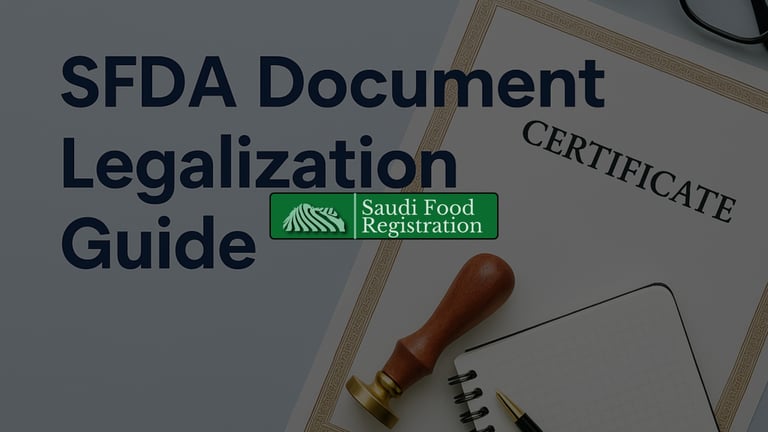SFDA Document Legalization: Step-by-Step Compliance Guide
Master SFDA document legalization. Follow exact MOFA, Chamber, and Embassy steps to get your SFDA documents approved without rejection | Saudi Food Registration
10/24/20253 min read


Document Translation & Legalization for SFDA Dossiers:
Exact MOFA–Chamber–Embassy Steps
When dealing with Saudi Food and Drug Authority (SFDA) registration, every stamp, translation, and document order matters.
Many importers lose weeks or even months because a single certificate was not legalized properly.
Understanding the exact sequence of translation and legalization—from your country’s Chamber of Commerce all the way to the Saudi Embassy and the Saudi MOFA—ensures zero rejections and faster SFDA approvals.
Why Legalization Is a Deciding Factor in SFDA Approvals
Legalization confirms that each document in your submission is authentic and officially recognized.
SFDA compares all uploaded certificates—like GMP, CFS, and LoA—with the seals and formats recognized by Saudi authorities.
One error in translation or a missing attestation can trigger rejection, delay import clearance, or even suspend your file.
Documents That Must Be Legally Prepared:
Certificate of Free Sale (CFS)
Good Manufacturing Practice (GMP) Certificate
Certificate of Analysis or Lab Reports
Manufacturing License or Export Permit
Halal Certification or Conformity Certificates
Letter of Authorization (LoA) and Power of Attorney
These are mandatory across food, supplements, cosmetics, and medical product categories—and must undergo the same legalization route.
The 5-Step Legalization Flow (Foreign → KSA)
Step 1: Certified Technical Translation
All documents must be professionally translated into Arabic by a technical translator familiar with SFDA terminology.
Automated or uncertified translations cause frequent errors in chemical names, ingredient lists, and product claims, often resulting in rejection or mismatched labeling.
Step 2: Chamber of Commerce Attestation
Your country’s Chamber of Commerce verifies that the issuing entity is legitimate.
Without this seal, later attestations by MOFA or the Embassy will be invalid. Ensure every page bears the official Chamber stamp.
Step 3: Ministry of Foreign Affairs (Home Country)
The MOFA in your home country confirms that the Chamber stamp and signatures are genuine. This endorsement is critical before submitting to the Saudi Embassy.
Step 4: Saudi Embassy / Consulate Legalization
This is the bridge between your home country and KSA.
Embassy officers verify translation accuracy, compare Arabic and English names, and authenticate the document for legal use inside Saudi Arabia.
Step 5: Saudi MOFA Attestation (Final Step)
Once in Saudi Arabia, your documents must be presented to the Saudi Ministry of Foreign Affairs. MOFA’s final stamp validates all prior attestations and makes your file SFDA-ready.
Common Rejection Triggers You Can Avoid
Missing or expired Chamber and MOFA stamps.
Uncertified Arabic translations or mismatched data between languages.
Legalization done out of sequence (for example, Embassy before MOFA).
Using copies instead of original stamped documents.
Inconsistent manufacturer or product names across documents.
Each of these issues halts the SFDA process, even if your product meets every compliance standard.
How Saudi Food Registration Ensures a Zero-Rejection File
Our Document Translation & Legalization Service manages every step of this process—accurately, quickly, and in full alignment with SFDA, SASO, and ZATCA requirements.
Our scope includes:
Certified Arabic translations for regulatory, technical, and scientific documents.
Coordination with Chambers, Embassies, and MOFA offices worldwide.
Review of scanned formats and naming conventions before SFDA upload.
Urgent fast-track legalization and courier handling for short deadlines.
We also pre-check each file against the latest SFDA e-platform requirements and document upload protocols, ensuring zero duplication and 100% compliance.
Best Practices for an SFDA-Ready Dossier
Translate all documents into Arabic before any attestation.
Keep issue and attestation dates aligned.
Upload clear, high-resolution scans with visible seals.
Revalidate certificates every six months if unused.
Maintain both Arabic and English copies in one organized dossier.
Why Legalization Is an Investment, Not a Cost
A properly legalized document set saves money and reputation. Each correctly attested file demonstrates reliability to Saudi regulators and builds brand trust with distributors. Delays, on the other hand, increase demurrage, reinspection costs, and market-entry barriers.
With our network and regional expertise, Saudi Food Registration ensures every detail meets Saudi and MENAT-region standards, so you can focus on launching your product instead of fixing paperwork.
Strengthen Your SFDA Application Further
To enhance your dossier success rate, explore complementary processes that align with document legalization:
Optimize your SFDA Labeling Compliance: Ensure translated labels, claims, and ingredients are consistent with legalized documents.
Streamline SFDA Import Approval: Learn how pre-checking import documentation reduces customs holds.
Master SFDA Product Classification: Understand how classification impacts document requirements and legalization scope.
Before submitting your documents, check our latest guide on SFDA CFS to ensure your Certificate of Free Sale meets all approval requirements.
Guide on SFDA health claims to see which statements get approved & how to stay compliant.
Contact us or use the chatbot to get your SFDA documents translated, legalized, and submitted correctly—without rejection or delays.
